Introduction to Manuscript Studies from Raymond Clemens and Timothy Graham
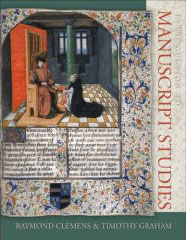 A wonderful new book on medieval illuminated manuscipts is coming from Cornell University Press in October. Drs. Raymond Clemens (Illinois State University) and Timothy Graham (University of New Mexico) are publishing Introduction to Manuscript Studies
A wonderful new book on medieval illuminated manuscipts is coming from Cornell University Press in October. Drs. Raymond Clemens (Illinois State University) and Timothy Graham (University of New Mexico) are publishing Introduction to Manuscript Studies which promises to become a must-have resource for anyone interested in the study of medieval calligraphy as well as those interested in re-creating the art in today’s world. It will be available in both hard and soft covers. From Cornell University Press:
Providing a comprehensive and accessible orientation to the field of medieval manuscript studies, this lavishly illustrated book by Raymond Clemens and Timothy Graham is unique among handbooks on paleography, codicology, and manuscript illumination in its scope and level of detail. It will be of immeasurable help to students in history, art history, literature, and religious studies who are encountering medieval manuscripts for the first time, while also appealing to advanced scholars and general readers interested in the history of the book before the age of print.
From the University of New Mexico press release:
The book explains in detail how parchment, inks and papers were made, and includes recipes used by medieval workmen. It explores the art of decoration and gives special attention to conventions of punctuation and abbreviation and the genres of manuscripts including books of hours, maps, calendars, rolls and scrolls. There is also an explanation of how to establish the origin and provenance of a manuscript.
Break open your piggy bank. This book looks like the best resource that has been published in many years.
[tags]medieval manuscript, calligraphy, medieval studies, cornell university press, raymond clemons, timothy graham[/tags]
August 28, 2007 Comments Off on Introduction to Manuscript Studies from Raymond Clemens and Timothy Graham
Medieval Treasures from the Cleveland Museum of Art Travel to the Ghetty
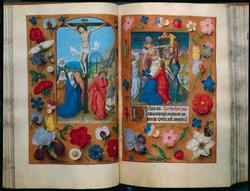 The Cleveland Museum of Art is the holder of many rare and beautiful medieval treasures including the Hours of Queen Isabella the Catholic, Queen of Spain, shown on the left. If you are in southern California this fall, you will be able to view part of this collection at the J. Paul Ghetty Museum. From the Ghetty press release:
The Cleveland Museum of Art is the holder of many rare and beautiful medieval treasures including the Hours of Queen Isabella the Catholic, Queen of Spain, shown on the left. If you are in southern California this fall, you will be able to view part of this collection at the J. Paul Ghetty Museum. From the Ghetty press release:
The Cleveland Museum of Art houses one of the finest and most comprehensive collections of Early Christian, Byzantine and European Medieval art in the world. This remarkable collection was largely acquired over a period of 90 years and formed by two of America’s most distinguished medievalists, the museum’s second director, William Milliken, and the collection’s former curator, William Wixom. The Cleveland Museum of Art’s $258 million renovation and expansion project created the opportunity for the first traveling exhibition to showcase more than 120 masterpieces in a variety of media from its medieval collection. Some of these objects will travel for the first time since they were acquired by the Cleveland Museum of Art.
“This exhibition offers a unique opportunity to bring some of the world’s finest medieval treasures to Los Angeles,†says Michael Brand, director, the J. Paul Getty Museum. â€It will present highlights from the Cleveland Museum of Art’s collection chronologically according to their place of origin, allowing visitors to appreciate the aesthetics of a particular time and place, as well as understand the general artistic progression during this significant period in European art.â€
[tags]cleveland museum of art, j. paul ghetty museum of art, medieval manuscript, medieval art[/tags]
August 22, 2007 Comments Off on Medieval Treasures from the Cleveland Museum of Art Travel to the Ghetty
The Book of Kells in the News
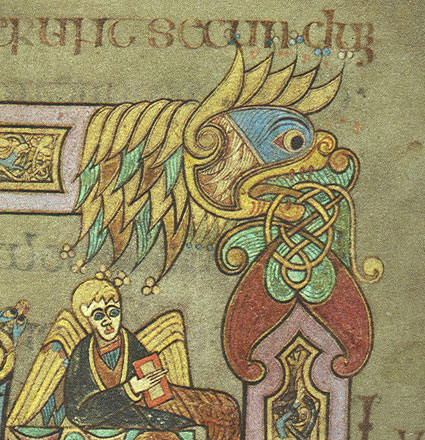
There may be no more famous example of an illuminated manscript than the Book of Kells. While it is well known as one of the most beautiful surviving illuminated manscripts, surprisingly, very little is actually known about the manuscript and its origins. Finally, modern science will be used to learn more about this treasure. From the Dublin Journal as reported in the New York Times:
Experts at Trinity College in Dublin, where the Book of Kells has resided for the past 346 years, are allowing a two-year laser analysis of the treasure, which is one of Ireland’s great tourist draws.
The 21st-century laser technology being used, Raman spectroscopy, encourages hopes among those with a romantic view for an ecclesiastical intrigue like “The Da Vinci Code†or “The Name of the Rose.â€
But the precise subjects are more mundane. The laser will study the chemicals and composition of the book, its pigments, inks and pages of fine vellum. Experts estimate that 185 calves would have been needed to create the vellum on which the art and scriptures were reproduced.
This news happens to coincide with the opening of The Medieval Scriptorium’s on-line gallery of images from the Book of Kells. I have to admit that the gallery is not complete. I haven’t had time to finish all of the captions for the images but I decided to introduce it in this post in light of the recent story referenced above.
[tags]Book of Kells, illuminated manuscript, celtic, calligraphy[/tags]
May 29, 2007 1 Comment
Poll Results – The 14th Century Black Death – Which Animal Survived Unscathed?
Twenty-three votes were cast in the Scriptorium’s first poll. The question was about the 14th century plague popularly referred to as the Black Death. While we commonly think of the rat acting as a host for fleas and the plague bacillus, it was certainly not the only animal that carried the disease. Besides humans and rats, most animals were susceptible to the bacillus and were infested with fleas. There was, however, one exception. These animals actually repelled fleas and humans who lived and worked closely with this species enjoyed some protection from the plague. The choices presented in the poll were pigs, cows, horses and sheep. The correct answer was the horse. From “The Black Death: Natural and Human Disaster in Medieval Europe” by Robert S. Gottfried:
…important as black rats were in the dissemination of plague, it is essential to emphasize that they were not the only secondary carriers. Along the other rodents already mentioned, additional secondary vector hosts included virtually all household and barnyard animals save the horse, whose odor apparently repels even starving blocked fleas.
Since first reading that short paragraph many years ago, I couldn’t help thinking that this little tidbit of knowledge could somehow be turned into a natural flea product. I’m sure it would probably be much less toxic than the chemicals we use to treat our pets today.
May 6, 2007 Comments Off on Poll Results – The 14th Century Black Death – Which Animal Survived Unscathed?
Medieval Scribe, John Myronas, a 13th Century Parchment Recycler
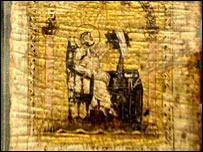 Yet another layer of history has been discovered in a Christian prayer book attributed to John Myronas. The most recent discovery is the third layer of text discovered in this recycled 13th century manuscript. In 2002, modern multi-sectional and multi-spectral imaging methods discovered greek writings from the 4th century. An article in the National Geographic News describes the earlier find:
Yet another layer of history has been discovered in a Christian prayer book attributed to John Myronas. The most recent discovery is the third layer of text discovered in this recycled 13th century manuscript. In 2002, modern multi-sectional and multi-spectral imaging methods discovered greek writings from the 4th century. An article in the National Geographic News describes the earlier find:
In 2002 researchers had uncovered writings by the mathematician Archimedes and the fourth-century B.C. politician Hyperides.
Last year one of the pages was found to contain a famous work by Archimedes about buoyancy that had previously been known only from an incomplete Latin translation.
A third layer has been been revealed and the details were presented today at the meeting of the American Philosophical Society by Reviel Netz and Roger Easton. From the BBC:
A series of clues, such as spotting a key name in the margin, led the team to its conclusion.
“The philosophical passage in the Archimedes Palimpsest is now definitely identified as a relatively early commentary to Aristotle’s Categories,” said Professor Netz.
He said that Aristotle’s Categories had served as the foundation for the study of logic throughout western history.
Further study has revealed the most likely author of this unique commentary is Alexander of Aphrodisias, Professor Robert Sharples from the University College London told BBC News.
If this is the case, he said, “it gives us part of a commentary previously supposed lost by the most important of those ancient commentators on Aristotle”.
From the National Geographic News:
n the 10th century a scribe had copied the ancient Greek manuscripts from papyrus scrolls onto parchment—thin leaves of treated animal skin.
Later the writing was washed out using a solvent such as orange juice and overwritten with new text—a process known as palimpsesting.
“In those days, parchment writing materials were so valuable that they were commonly reused when the book was considered out of date or if the subject was judged inappropriate or less valuable,” Roger L. Easton, of the Rochester Institute of Technology, wrote in an email.
By the 12th century, pages from five different earlier works had been erased, overwritten, and compiled into a Christian prayer book, the Euchologion—what is now called the Archimedes Palimpsest.
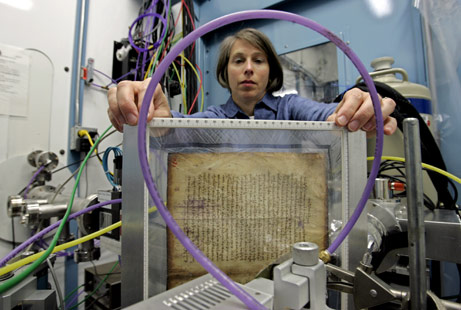
As always, books are multi-layered treasures. I wonder what else might be discovered in this 13th century prayer book?
[tags]Euchologion, Archimedes Palimpsest, Aristotle, Christian Prayer Book, 13th century, John Myronas, Philisophical Society, Archimedes, parchment, illuminated manscript[/tags]
April 26, 2007 Comments Off on Medieval Scribe, John Myronas, a 13th Century Parchment Recycler

